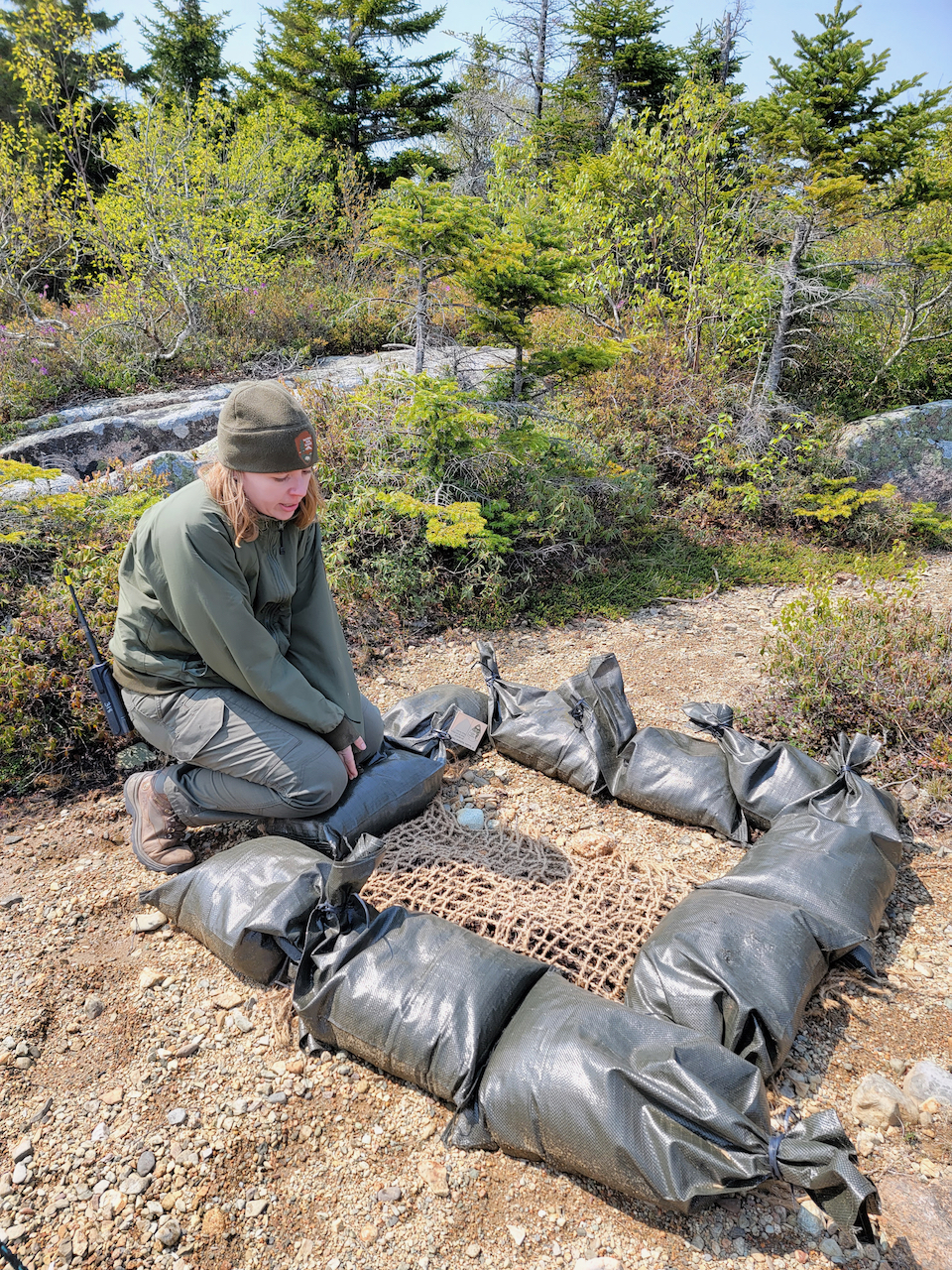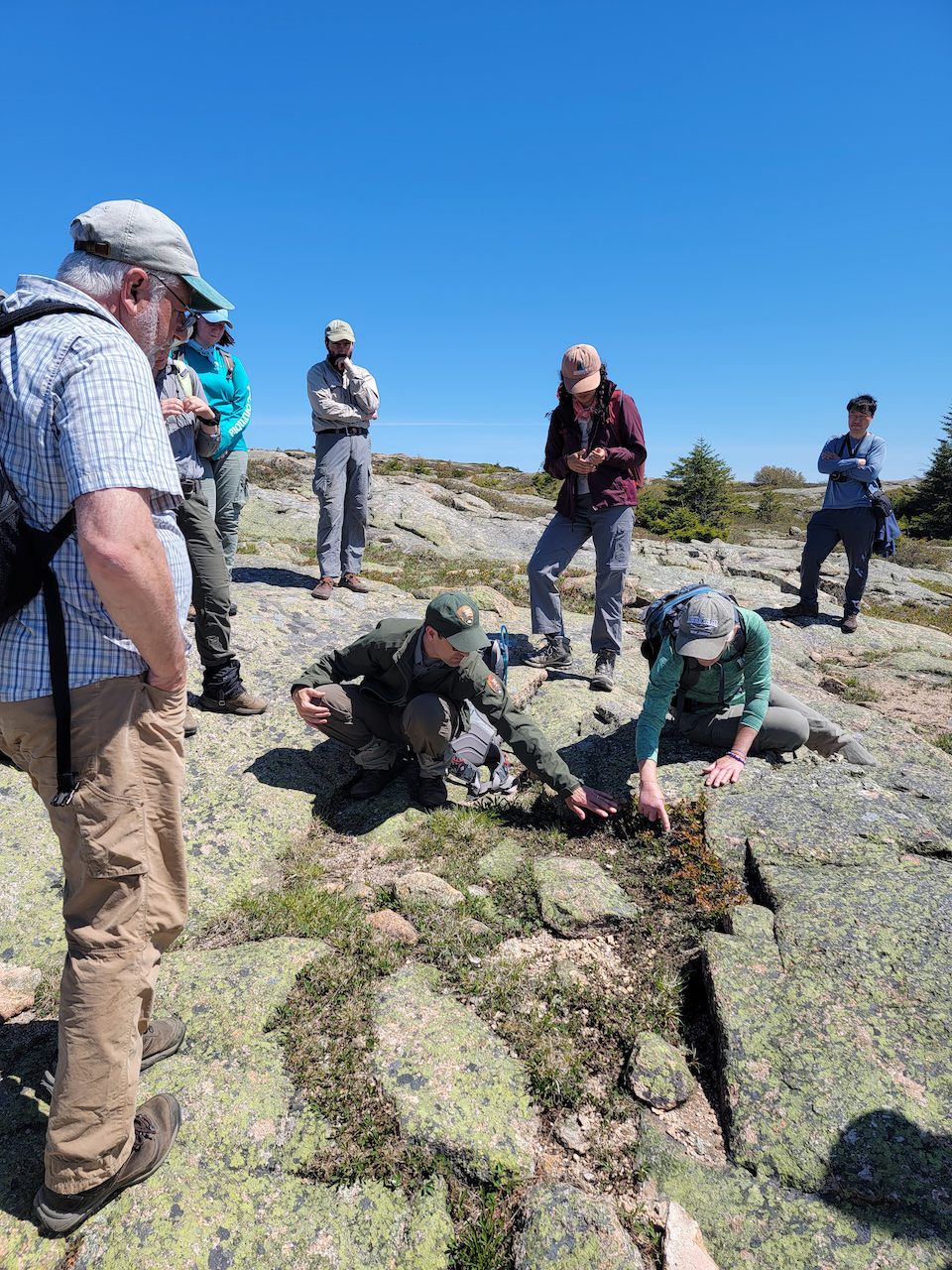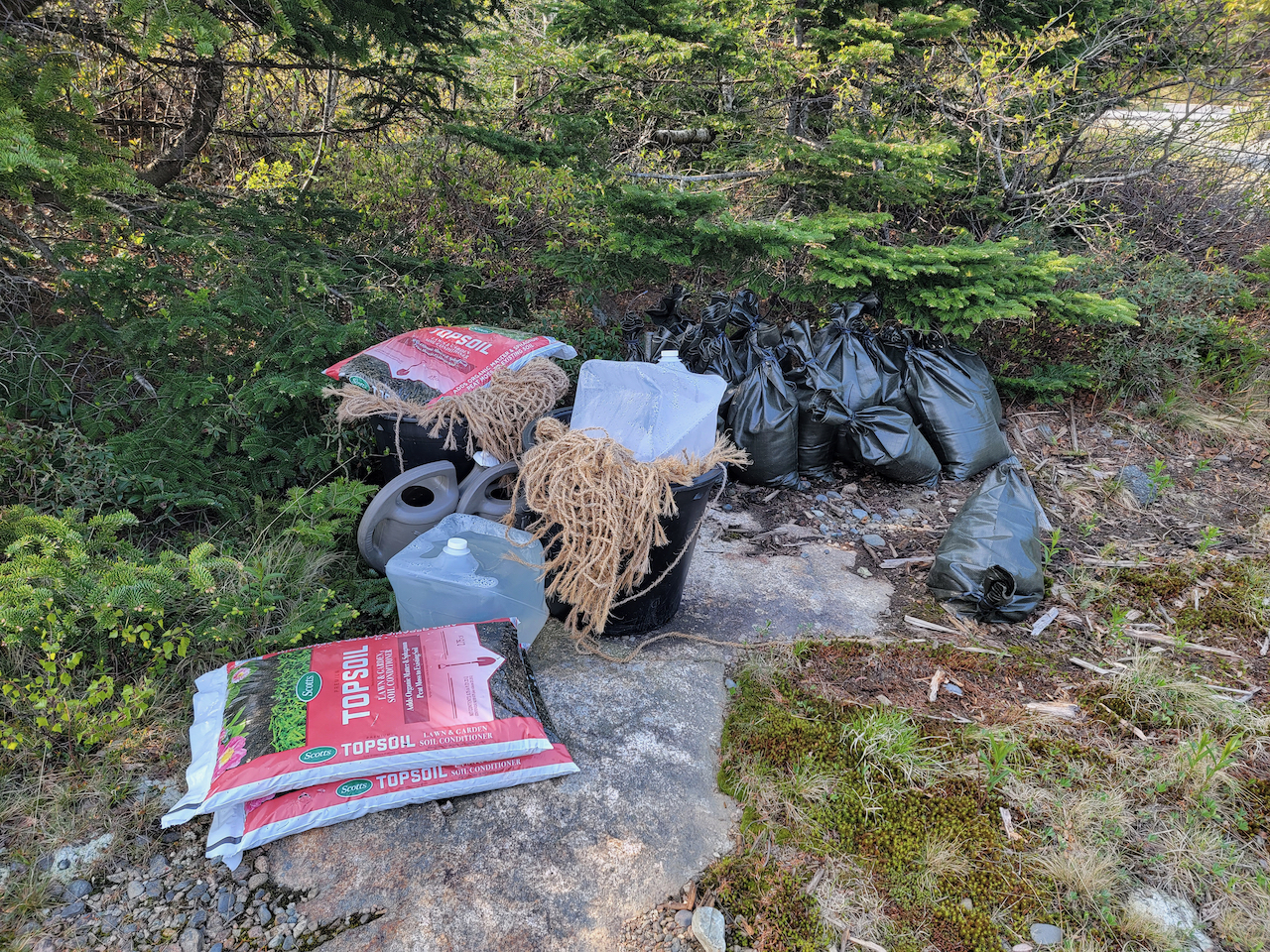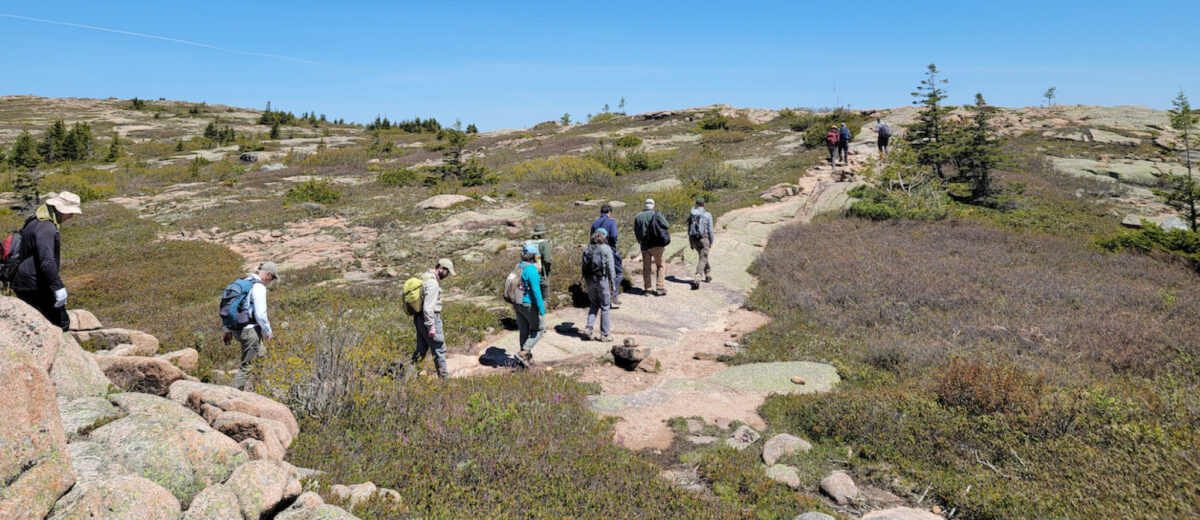story + photos by Catherine Schmitt
 Emma Lanning stared at a roped-off rectangle on the top of Cadillac Mountain, as an eastern towhee called drink-your-tea! from the top of a nearby spruce. Lanning, a biological science technician with Acadia National Park, had applied a slurry of ground-up moss and lichen to the area last year as part of ongoing efforts to restore vegetation on the summit.
Emma Lanning stared at a roped-off rectangle on the top of Cadillac Mountain, as an eastern towhee called drink-your-tea! from the top of a nearby spruce. Lanning, a biological science technician with Acadia National Park, had applied a slurry of ground-up moss and lichen to the area last year as part of ongoing efforts to restore vegetation on the summit.
She put her nose close to the granite, looking for any signs of life, but saw no growth on the gravelly rock.
Lichen and mosses evolved to make energy from the sun and draw minerals and nutrients from air, water, and stone. As they grow from fragments and spores, they become branched and leafy, collecting rain and particles of drifting dust, creating conditions for seeds and roots to take hold. More plants arrive, soil accumulates, and eventually a “climax community” of specialist vegetation has emerged.
At least, this has been the scientific idea about how vegetation becomes established in extreme settings such as Acadia’s wind-blown, fog-soaked, sun-baked, ice-covered summits.
Some 145 plant species grow on Acadia’s mountains, in clumps and islands sheltered by bedrock benches, tucked into crevices, and rooted around wet seeps and pools. Their low-growing nature, and their tendency to grow in the same areas where people want to be, makes summit plants prone to footsteps and erosion.
“We have identified different types of degraded areas, including unofficial trails created by people taking shortcuts, and ‘sandwich spots’ where people sit to have lunch and take in the view,” said Chris Nadeau of Schoodic Institute. Nadeau, along with Jessie Wheeler and Abe Miller-Rushing of Acadia National Park, with support from Friends of Acadia, had invited a group of experts to tour Acadia’s summits and advise on the next phase of restoration studies. Previous research had shown the importance of adding soil for successful plant growth, and the voluntary appearance of lichen and moss in some of the restoration areas prompted the slurry experiment that Lanning had inspected.
Among the advisors on Cadillac were Katie Vinzant, a vegetation ecologist with the National Park Service based in Denver, Colorado, Michael Piantedosi of the Native Plant Trust, botanist Jill Weber, who along with Native Plant Trust has been working on the restoration since its beginning and describes herself as “the memory keeper for vegetation in the park,” and Scott Abella, associate professor in restoration ecology at University of Nevada Las Vegas.
 Abella’s experience was in the desert, where lichens and bacteria form a living crust that protects soil from erosion. But as he studied the shrubs clustered on Cadillac, Abella questioned whether the biocrust idea was applicable. It wasn’t entirely clear how the plants got started. There was no soil-associated lichen by itself; only the spreading runners of three-toothed cinquefoil and sprouts of mountain sandwort appeared alone in the coarse gravel. Were they the surviving remnants of eroded vegetation, or initiators of new shrub islands? No one seemed to know how the summit plant communities originated. They did, however, know how they ended.
Abella’s experience was in the desert, where lichens and bacteria form a living crust that protects soil from erosion. But as he studied the shrubs clustered on Cadillac, Abella questioned whether the biocrust idea was applicable. It wasn’t entirely clear how the plants got started. There was no soil-associated lichen by itself; only the spreading runners of three-toothed cinquefoil and sprouts of mountain sandwort appeared alone in the coarse gravel. Were they the surviving remnants of eroded vegetation, or initiators of new shrub islands? No one seemed to know how the summit plant communities originated. They did, however, know how they ended.
John Daigle of the University of Maine and former graduate student Min-Kook Kim, now at Marshall University, also part of the advisory group, explained how they used satellite imagery and aerial photography to detect vegetation loss and recovery on Cadillac Mountain over several recent time periods. They documented the return of vegetation after the National Park Service set up ropes and signage to keep people on trails, but continued loss in other areas.
At the overlook off the Cadillac West Parking Lot, the group noted fresh areas of erosion in and around stands of rare alpine blueberry and blooming pin cherry. A popular place for watching the sunset, the bedrock slope is also vulnerable to rain storms of increasing intensity. Once plants are damaged, an inch of rain can easily wash away what took decades or centuries to build.
+ + +
The granite is what has made these mountains famous.
“The summits are all bare and rocky. The slopes are covered with pines, firs, and birches. I named it Isle des Monts Desert,” wrote French explorer and map-maker Samuel de Champlain in 1604, when he sailed to what would become Acadia. From his ship, Champlain exchanged gifts and “good will” with the island’s Wabanaki residents, but he did not ask them about the land. He did not climb the monts desert, and thus he did not discover that the hills were not bare. The mountains were streaked with moss, lichen, tufts of grass and sedge, low-growing shrubs (azalea, shadbush, holly, alder) and stunted trees (birch, ash, spruce, fir), their roots woven into a crust-like mat. The high elevation and cool ocean breeze had allowed some species to thrive long after the rest of the surrounding landscape had become too warm.
When William Alden photographed the Mount Desert landscape in 1907, his work to illustrate Florence Bascom‘s report on the geology of the island, he, too, was focused on the rocks. But a close examination of his images shows plenty of vegetation, dark and lush, on the summits.
Fire was and is another threat to summit plants. When Barrington Moore mapped vegetation on Mount Desert Island in the 1920s, he delineated islands of evergreens and bare rock within extensive “burned areas.” The Fire of 1947 burned up the east side of Cadillac Mountain and the northeast slope of Sargent Mountain. Plants returned to high elevation areas eventually. However the process of succession played out, the scientists working on the summit today know they can’t wait that long.
+ + +
 The air is getting hotter and the rain is falling harder and more and more people are visiting Acadia. Not only are plants on the summit unique and rare, providing habitat for birds and other wildlife, they help hold soil in place and soak up precipitation, preventing washouts like the runaway train of water that blew out the Maple Spring Trail and carriage roads in June 2021.
The air is getting hotter and the rain is falling harder and more and more people are visiting Acadia. Not only are plants on the summit unique and rare, providing habitat for birds and other wildlife, they help hold soil in place and soak up precipitation, preventing washouts like the runaway train of water that blew out the Maple Spring Trail and carriage roads in June 2021.
“What we want to know,” said Nadeau, “is how to restore vegetation in a way that will be resilient to increasing temperatures and more intense and erratic precipitation.”
The goal is to have revegetation within five to ten years, according to Abe Miller-Rushing. Which means they also can’t wait for the typical process of science to play out. So Acadia, and its partners Schoodic Institute and Friends of Acadia, have sought a compromise. “By designing the restoration as an experiment, we learn without having to wait for research,” said Nadeau.
Previous studies and input from the advisors resulted in a plan for this year that involves burlap bags, fiber netting, and seeds collected from local wild plants, especially fast-growing members of the summit community that can tolerate stress. Emma Lanning said it’s too early to tell if the biocrust slurry worked, but they plan to apply more of the lichen-moss mix to some of the test plots later in the summer, and continue to monitor. They also plan to add soil – lots and lots of soil, carried to the tops of Sargent and Penobscot mountains by hundreds of volunteers.
Of course, none of it will work if people continue to make shortcuts and step on plants as heat and storms continue to affect the mountains. Whatever the origins of the plant communities, the desert adage “don’t bust the crust” still applies. In the end, human behavior will determine whether or not we can save our summits.
